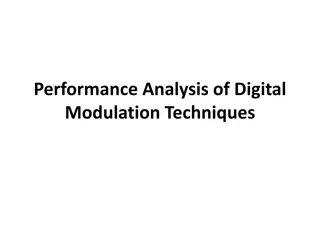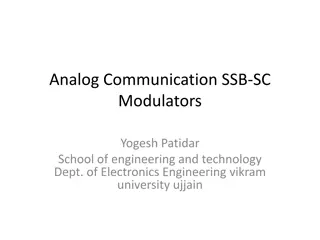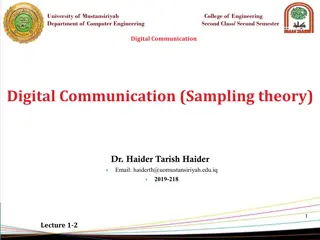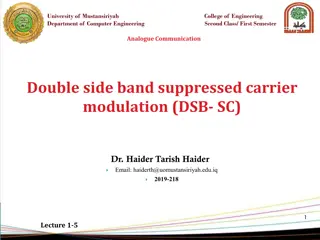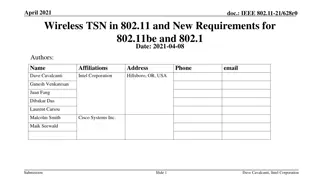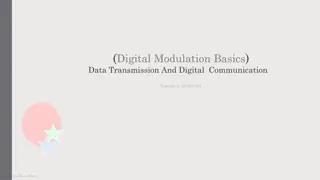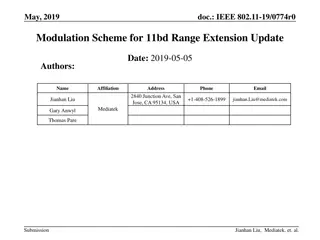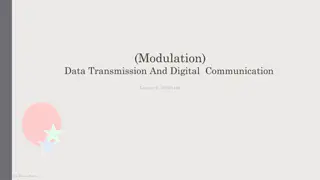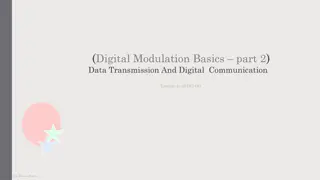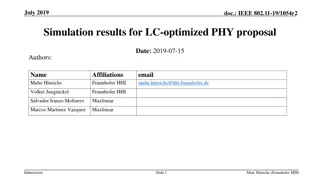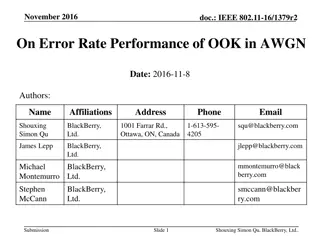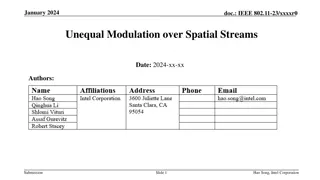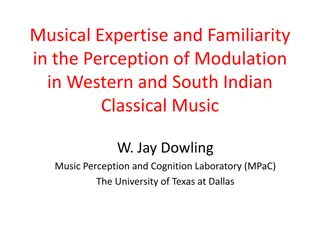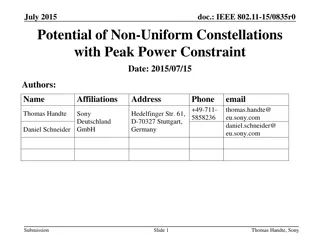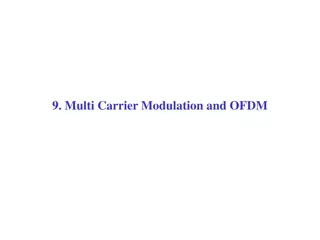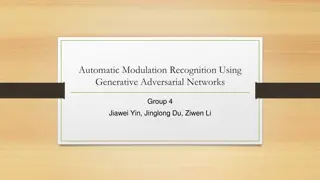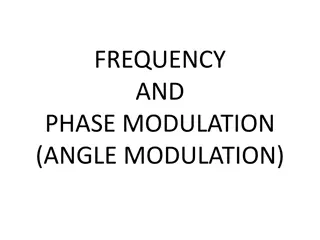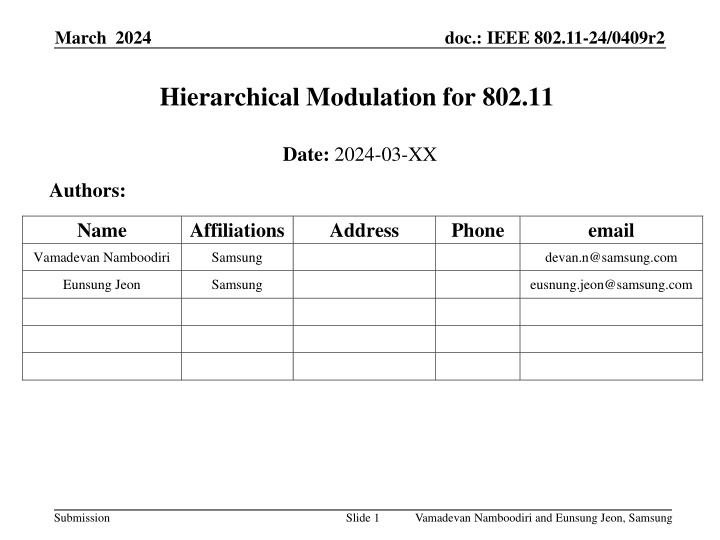
Hierarchical Modulation for Improved WLAN Connectivity
Explore the innovative Hierarchical Modulation (HM) proposal by Samsung for IEEE 802.11, aiming to enhance reliability and reduce latency in WLAN connectivity under interference scenarios. The concept involves modulating high and low priority data streams into a single symbol stream, providing better reception under varying conditions. Learn how HM addresses key challenges in WLAN performance, offering potential benefits in reliability, latency, and throughput optimization.
Download Presentation

Please find below an Image/Link to download the presentation.
The content on the website is provided AS IS for your information and personal use only. It may not be sold, licensed, or shared on other websites without obtaining consent from the author. If you encounter any issues during the download, it is possible that the publisher has removed the file from their server.
You are allowed to download the files provided on this website for personal or commercial use, subject to the condition that they are used lawfully. All files are the property of their respective owners.
The content on the website is provided AS IS for your information and personal use only. It may not be sold, licensed, or shared on other websites without obtaining consent from the author.
E N D
Presentation Transcript
March 2024 doc.: IEEE 802.11-24/0409r2 Hierarchical Modulation for 802.11 Date: 2024-03-XX Authors: Name Affiliations Address Phone email Vamadevan Namboodiri Samsung devan.n@samsung.com Eunsung Jeon Samsung eusnung.jeon@samsung.com Submission Slide 1 Vamadevan Namboodiri and Eunsung Jeon, Samsung
March 2024 doc.: IEEE 802.11-24/0409r2 Introduction UHR PAR seeks to Improve reliability of WLAN connectivity Reduce latencies Increase manageability Increase throughput Reduce device level power consumption Hierarchical Modulation can address several of the above Improve Reliability Reduce Latency Increase Throughput in interference scenarios Submission Slide 2 Vamadevan Namboodiri and Eunsung Jeon, Samsung
March 2024 doc.: IEEE 802.11-24/0409r2 What we propose We propose a slight modification in the current QAM mapping. We call it, Hierarchical Modulation (HM) The scheme is agnostic to the existing and proposed 802.11 features such as SU-MIMO, MU-MIMO, OFDMA (rRUs, dRUs) etc. Note: HM is not a technic to improve absolute throughput but to improve reliability especially under interference Submission Slide 3 Vamadevan Namboodiri and Eunsung Jeon, Samsung
March 2024 doc.: IEEE 802.11-24/0409r2 Hierarchical Modulation : Overview of the Idea An Example of Transmitter Block Diagram bit processing unit in today s 802.11 a/g/n/ac/ax/be Transmitter Prepend service field Append tail bits Append pad bits HP-data stream Group bits into symbols Conv/LDPC Encoder Scrambler Interleaver Assembly HP & LP data steams I Modulator /Mapper Prepend service field Append tail bits Append pad bits Q LP-data stream Group bits into symbols Conv/LDPC Encoder Scrambler Interleaver symbol stream Yellow block combines the 2 data streams and presents to the Mapper Submission Slide 4 Vamadevan Namboodiri and Eunsung Jeon, Samsung
March 2024 doc.: IEEE 802.11-24/0409r2 Hierarchical Modulation: Features Bits from two different data streams (PPDUs) are modulated into a single symbol stream. High priority (HP) stream Low priority (LP) stream Receivers with good reception conditions can receive both data streams, while those with poor reception conditions may only receive the HP stream. Typically, the HP stream is of lower bit-rate, but has higher robustness than the LP one. HP and LP streams can be used for two completely different services. Submission Slide 5 Vamadevan Namboodiri and Eunsung Jeon, Samsung
March 2024 doc.: IEEE 802.11-24/0409r2 Hierarchical Modulation: How it works? (1/2) Consider a 64QAM modulation as shown in the figure below [1]. The upper 2 bits are same for a given quadrant. Like QPSK modulation The lower 4 bits changes within any given quadrant Like 16QAM modulation 010100 000100 HP - QPSK 100100 00 01 11 10 Submission Slide 6 Vamadevan Namboodiri and Eunsung Jeon, Samsung
March 2024 doc.: IEEE 802.11-24/0409r2 Hierarchical Modulation: How it works? (2/2) Let s say we have two data streams which go onto a Symbol (PHY) stream Map the 2 bits from data stream-1 to the MSBs of the IQ symbol QPSK modulation Use the 4 bits from data stream-2 to the LSBs of the IQ symbol 16QAM modulation We can have different FEC mechanism for each of these streams. To demodulate at the receiver, calculate the LLRs for the 2-MSBs as if it is a QPSK modulation Calculate the LLRs of the 4-LSBs as if it is a 64- or 16QAM modulation (Option 1) 64QAM demodulation and discard 2-LSBs (Option 2) 16QAM demodulation using the two-stage detection Run 2 FEC decoders (LDPC and/or Viterbi) and recover the 2 streams. If the SNR is appropriate, both the streams will be decodable. In a noisy environment, the LP stream need not be decodable. SNR requirements for decoding LP stream will be similar to that is required for 64QAM signal. In this case only the HP stream may be decodable. Submission Slide 7 Vamadevan Namboodiri and Eunsung Jeon, Samsung
March 2024 doc.: IEEE 802.11-24/0409r2 Transmissions in the presence of interference Final selected Constellation size HP/LP QPSK/QPSK QPSK/16QAM 16QAM/64QAM 64QAM/64QAM 16QAM 64QAM 1024QAM 4K-QAM If one of the above partitions, e.g., QPSK/16QAM (2nd row) is chosen, the HP stream will have more than 2dB SNR margin than the LP stream (SISO uncoded BER vs SNR plots are given at the end). Submission Slide 8 Vamadevan Namboodiri and Eunsung Jeon, Samsung
March 2024 doc.: IEEE 802.11-24/0409r2 An Example Set of System Parameters Let s consider 20MHz, 802.11be, SISO configuration. 234 data carriers Let each subcarrier is modulated with 64QAM. Let the HP stream is QPSK modulated (within the 64QAM) with code- rate 1/2 (MCS1) Let the LP stream is 16QAM modulated (within the 64QAM) with code- rate 3/4 (MCS4) Therefore HP data rate: (1,000,000/16) * 234 * 2 * = 14.625Mbps LP data rate: (1,000,000/16) * 234 * 4 * = 43.875Mbps Combined data rate: 14.625 + 43.875 = 58.5 Mbps Note that the HP stream is more protected than the LP stream at the cost of reduced data rate compared to EHT-MCS 5 (i.e., 64QAM with code rate 2/3) Submission Slide 9 Vamadevan Namboodiri and Eunsung Jeon, Samsung
March 2024 doc.: IEEE 802.11-24/0409r2 Receiver Design Considerations May use Linear detection (MMSE, ZF) or non-linear detection (ML/near ML) Consider 64 QAM modulation with QPSK for HP stream At the receiver, calculate the LLRs for the 2-MSBs as if it is a QPSK modulation Calculate the LLRs of the 4-LSBs as if it is a 64QAM modulation Run 2 FEC decoders (LDPC and/or Viterbi) and recover the 2 streams. For HP stream The LP data (The variation among the points in the cloud) has the same effect of white noise The HP receivers will experience higher noise level, due to LP stream, thus penalizing the HP stream performance.[2] This penalty depends on the constellation ratio between HP and LP and constellation shape etc. Submission Slide 10 Vamadevan Namboodiri and Eunsung Jeon, Samsung
March 2024 doc.: IEEE 802.11-24/0409r2 General Observations on HM In 802.11 PHY we presently have Spatial division multiplexing Among Single Users (SU-MIMO) Multiple data streams to a single user. Among Multiple Users (MU-MIMO) Independent data streams to multiple-users Frequency division multiplexing among single user (OFDM) Multiple sub-carriers to a single user. Among Multiple Users (OFDMA) Independent Resource Units to multiple users. We propose Modulation Multiplexing Among same user (SU SISO/MIMO) HP and LP streams to the same user. Among multiple Users HP stream to user-1 and LP stream to User - 2. Semi Orthogonal Multiple Access (SOMA) introduced in [5] is a similar concept Submission Slide 11 Vamadevan Namboodiri and Eunsung Jeon, Samsung
March 2024 doc.: IEEE 802.11-24/0409r2 Applications Submission Slide 12 Vamadevan Namboodiri and Eunsung Jeon, Samsung
March 2024 doc.: IEEE 802.11-24/0409r2 Transmissions in the presence of interference Final selected Constellation size HP/LP QPSK/QPSK QPSK/16QAM 16QAM 64QAM Let s say the 2nd row is chosen Send the Must Reach PPDUs in HP stream HP stream will have more than 2dB SNR margin than the LP stream. Submission Slide 13 Vamadevan Namboodiri and Eunsung Jeon, Samsung
March 2024 doc.: IEEE 802.11-24/0409r2 SNR= -~16dB Multi-User Transmission STA2 Sharing modulation across users Example Consider STA1 is near and STA2 is far from an AP. Let the receive SNR from AP to STA1 is sufficient to support 64QAM transmissions with LDPC coding. Let the receive SNR from AP to STA2 is low Let the STA2 is sensitive to transmission delays. AP1 SNR= ~20dB STA1 In this example, data stream-1 can be modulated with (16QAM, LDPC coding) which is addressed to STA1 while data stream-2 can be modulated to (QPSK, Conv. coding). It can be addressed to STA2. Submission Slide 14 Vamadevan Namboodiri and Eunsung Jeon, Samsung
March 2024 doc.: IEEE 802.11-24/0409r2 More applications mm-Wave Transmission Will experience substantial received-power fading for movements over short distances. Human induced fades can range from 18 to 36dB! Can last on the order of 10s to 100s of milli-seconds. HP/LP architecture can provide more reliability and/or effective throughput. Latency Sensitive Transmission Both time-critical latency sensitive (LS) traffic and ordinary traffic can be scheduled simultaneously using HP/LP architecture. Unequal Error Protection (UEP) Alternative way of enabling UEP is to use the hierarchical modulation Submission Slide 15 Vamadevan Namboodiri and Eunsung Jeon, Samsung
March 2024 doc.: IEEE 802.11-24/0409r2 Summary We introduced hierarchical modulation and its applications for the improvement of 802.11 systems. Transmissions in the presence of interference Multi-user transmission mm-Wave transmission Latency sensitive transmission Alternate mechanism for Unequal Error Protection Submission Slide 16 Vamadevan Namboodiri and Eunsung Jeon, Samsung
March 2024 doc.: IEEE 802.11-24/0409r2 Reference [1] A Brief Introduction: DVB-T Hierarchical Modulation, March 2000 [2] A Hierarchical Modulation for Upgrading Digital Broadcast Systems: IEEE TRANSACTIONS ON BROADCASTING, VOL. 51, NO. 2, JUNE 2005 [3] BER computation of 4/M-QAM Hierarchical Constellations : IEEE Transactions on Broadcasting, Vol 47. No 3, Sept 2001 [4] A recursive Algorithm for the exact BER computation of Generalized Hierarchical QAM Constellations : IEEE Transactions on Information Theory , Vol 49, No 1, January 2003. [5] introduction to SOMA (802.11-16/0943r0) Submission Slide 17 Vamadevan Namboodiri and Eunsung Jeon, Samsung

